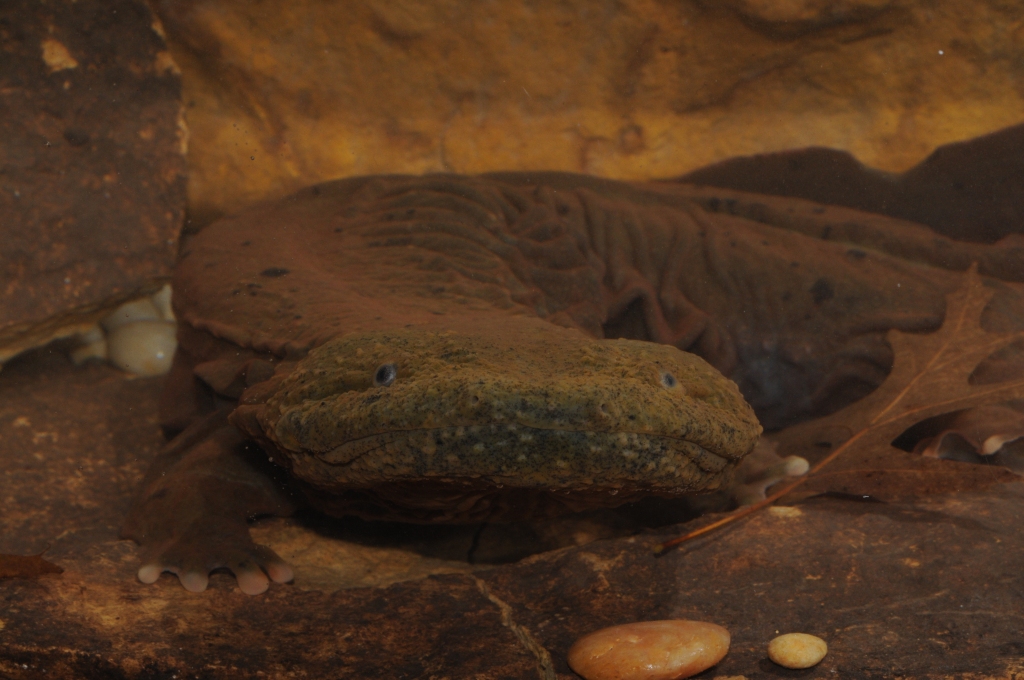By Michaela Lambert

When most people learn about the Eastern Hellbender, the largest salamander in North America, they wonder how something so big could go unnoticed.
They are “extremely cryptic,” said Sarah Tomke, a doctoral candidate studying Hellbenders at the University of Kentucky. Hellbenders, which grow to about two feet long, have an uncanny ability to blend into their surroundings, and their flat bodies allow them to fit into crevices under rocks.
Adding to the mystery, most records that exist about the Hellbender’s whereabouts in Kentucky are from accidental captures by anglers or field biologists. When scientists conducted a statewide survey in 2011 to determine where these large salamanders live, very few were found.
But most biologists agree: Populations of this elusive amphibian are in danger.
“At this point in time, we only know of one population that is still reproducing,” said Tomke, a former technician with the Kentucky Department of Fish and Wildlife Resources (KDFWR). “Given that fact, things do not look good.”
Tracking the Hellbender’s Environmental DNA
Although the Eastern Hellbender is currently not considered a federally endangered species, they are considered a Species of Greatest Conservation Need in Kentucky due to the uncertainty in their population numbers and distribution.

In an effort to save the Eastern Hellbender, Tomke is working as part of a collaboration between KDFWR and the University of Kentucky.
Last September, Tomke and KDFWR technicians began collecting water samples from around the state to analyze them for DNA left behind by Hellbenders through skin cells, saliva, excrement and reproductive sources.
“It can be very difficult to capture a small amount of DNA that may be floating around in the water,” Tomke said.
Certain water conditions, such as high turbidity, or an abundance of suspended material in the water, can make it even more challenging to detect Hellbender environmental DNA.
“Luckily for us, today’s genetic technology is incredibly powerful,” Tomke said. “If a single strand of DNA is present in our water sample, we are able to detect it.” Environmental DNA, or eDNA, has become the primary tool to assess the current distribution of Hellbenders for many states, including Tennessee, North Carolina, Pennsylvania, West Virginia and New York.
In most of these states, Hellbenders were not detected in a large portion of historically known populations and only in a few instances were new populations discovered.
“A lot of revealing information has been found because of this,” Tomke said. “Unfortunately, it is mostly bad news.”
Though eDNA detection is a powerful tool for determining whether Hellbenders are present in a stream, it does not give any indication to the number or age of individuals within it. Once Tomke and her team have finished analyzing water samples, most likely sometime next year, they will follow up with in-person stream searches in areas where eDNA was detected to attempt to determine population size.

After that, the team plans to construct nest boxes, concrete structures with removable lids designed to mimic the Hellbender’s natural habitat, in locations where Hellbenders have been located. The team will be able to regularly check the boxes for the presence of Hellbenders and Hellbender nests without disturbing critical habitat.
This will give the team some insight into the age and distribution of Kentucky populations and if they are successfully reproducing or not. Once the team has a better idea of where the Hellbenders are located and whether or not they are reproducing, they can determine if further research or management efforts are necessary.
“Our biggest concern right now is that individuals in our current populations are very old and no longer reproducing, so when they eventually die that population will no longer exist,” Tomke said. “If we end up consistently finding nests, it will be a big relief for us.”
An Important Water Quality Indicator
Water pollution is among the greatest threats to the Eastern Hellbender. Entirely aquatic, Hellbenders breathe through their skin, which makes them sensitive to contamination and chemical changes in the water.
Because the Kentucky Division of Water is charged with protecting and restoring Kentucky’s waterways — including the streams that Hellbenders inhabit — it plays a role in preservation of the species.
“The job of the Kentucky Division of Water is to ensure that everyone has access to clean water that is fishable, swimmable and drinkable — even the wildlife,” said Dale Booth, supervisor of the DOW Nonpoint Source and Basin Team Section. “We do this by regulating sources of pollution, and also giving communities the tools and information they need to make smart water choices.”
The primary pollutant of concern for Hellbenders is sediment, a type of nonpoint source pollutant.

Nonpoint source pollution, also called runoff pollution, does not come from a single defined source, such as a pipe. Rather, it is carried by stormwater runoff over the landscape into surface or groundwater. Once it reaches the stream, sediment makes the water more turbid, making it harder for animals in the creeks to see and breathe. Sediment also buries critical habitat for creatures like the Hellbender.
Because nonpoint source pollution cannot be traditionally regulated, addressing these issues requires communities and individuals to take voluntary actions to change the way they interact with the landscape to reduce pollution.
Within DOW, the Nonpoint Source and Basin Team Section of the Watershed Management Branch works to abate nonpoint source water pollution by promoting watershed planning, which involves groups of interested citizens within a watershed coming together to develop a plan for restoring their waterways. These groups work together to identify pollutants and their potential sources and then develop a plan to restore the watershed through the use of best management practices.
In Kentucky, groups can apply for federal funding through DOW to implement the action items identified in their plans.
Booth said DOW has awarded grants to projects across the state that are working to reduce nonpoint source pollution. In Northern Kentucky, the program has funded work to install wetlands that help to soak up and slow down storm water, which results in reduced erosion in streams. The Division also works with farmers to fence livestock out of creeks, provide alternative water sources and plant cover crops.
“All of these best management practices help reduce sediment in our waterways, as well as reducing nutrients and bacteria, leading to cleaner streams and better habitat,” Booth said.
Learn more about Clean Water Act 319(h) funding here.
How to Help the Hellbender
Landowners and citizen scientists can also play a role in preserving the Eastern Hellbender.
KDFWR At-Risk Species Biologist Zack Couch suggests that people sign up for Kentucky Wild, a membership program that directly supports vulnerable wildlife facing threats in the state. Members pay a small fee to have the opportunity to go into the field with biologists and receive some cool stuff in return. The funds generated from those fees directly benefit at-risk species conservation in Kentucky.

“Hellbenders are fascinating and mysterious creatures that I’ve been fortunate enough to be able to observe several times in the wild,” Couch said. “Not only that, but finding a Hellbender in a creek is a great indicator of a healthy stream system that isn’t being impacted by erosion and sedimentation.”
What should you do if you happen to see a Hellbender while you are adventuring in a Kentucky stream? According to Couch, the first thing you should do when you find or accidentally capture a Hellbender is take care not to kill it. Secondly, take a georeferenced photo (most cell phones do this automatically) and send it, along with county, date and location information, to KDFWR State Herpetologist John MacGregor. This will help KDFWR fill the knowledge gap of where Hellbenders are found.
Finally, if the Hellbender was accidentally caught, it should be released where it was found. Hellbenders should spend little to no time outside of the water and should not be handled unless absolutely necessary.
Tomke and Couch agree that saving the Eastern Hellbender will be a group effort
“It has become very clear to us that creating partnerships among various agencies and organizations will be the key to conserving Hellbenders in the United States,” Tomke said.
Michaela Lambert is an environmental scientist with the Kentucky Division of Water. She has a passion for freshwater systems and wildlife and frequently attends water-related education events.
Categories: All, Environmental Protection, Water






